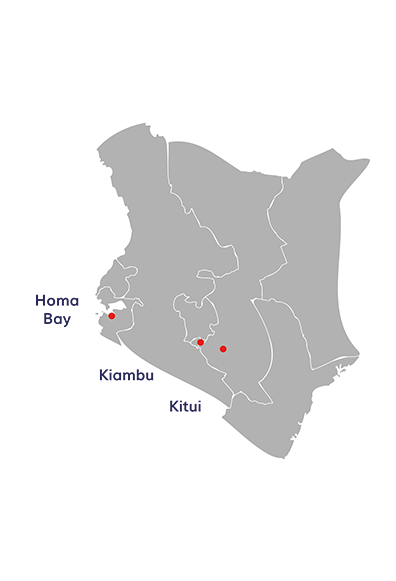Countries:
Kenya
Status:
Completed
Sector:
Energy
Demonstrating community cooling hub models as an affordable, low-carbon solution to meet rural community cooling needs.
Cold chains are vital for a well-functioning society and economy. They underpin access to safe medicines, nutritious food and contribute to socio-economic development. However, access to end-to-end cold chains is limited in Kenya, causing a significant food and value loss with social, economic, and environmental knock-on impacts.
Focused on clean energy options for refrigeration, the project aimed to support the development of sustainable, resilient, and equitable food and vaccine cold chains as part of the country’s critical infrastructure. This was to reduce emissions and support progress towards wider socio-economic goals (especially in rural communities) by improving cooling services across the agricultural and health supply chains – leading to reduced food loss and better health outcomes.
Through the Community Cooling Hub (CCH), the project delivered a novel approach that provided a clean cold storage solution. An integrated systems approach was used to meet the broad portfolio of cold chain (and wider cooling) needs of rural people as well as SME owners in developing markets.
The UK PACT support enabled the project to test and validate the design of sustainable cooling/thermal and cold chain hubs near farms, and to develop suitable business models that make the CCH model highly accessible, efficient, affordable, resilient, and sustainable for current and future needs.
The project was delivered by the University of Birmingham in partnership with London South Bank University and the African Centre for Technology Studies (ACTS).
“I’m happy with the CCH implementation progress and urge the community to continue supporting the project. Farmers are losing a lot of their produce due to PHL and the inadequate market. Therefore, the community should continue committing to the project as this will result in better benefits once the facility is operational.”
Ms. Tabby Kamau
Local Administration officer,
Kiambu county
"It’s important that all the stakeholders come together and ensure the CCH project succeeds. This is because the project will result in additional benefits apart from reduction of post-harvest losses, such as an increase in youth employment, farmers income, and more.”
Mr. Mbugua
Chairman, Kiriita Dairy Cooperative Chairman

households surveyed to collect data on local cooling and cold chains needs
interviews held to support the development of a model framework and mapping of community cooling needs
focus groups organised to discuss the value of CCH and improve decision makers’ understanding of the community cooling solutions design
Stakeholder workshops delivered to validate data, provide feedback on the design, and share knowledge on the importance of the CCH
The project adopted a needs-based systems approach to demonstrate and upscale the CCH model as a low-carbon development strategy in Kenya. This was achieved through a number of activities:
Vulnerable and marginalised groups were included in all consultative and participatory activities
Specific cooling needs from GESI groups were captured in the data collection to inform CCH design
Identified employment opportunities and health benefits for GESI groups from the development of cooling and cold chain services
Addressed access to credit barriers through innovative pay-as-you-go business models
The project was highly participatory by design, ensuring GESI mainstreaming at every phase. Most importantly, it used a bottom-up approach where the cold chain and cooling needs of the vulnerable and marginalised groups (particularly women and youths) were captured using the needs assessment framework.
The lack of cooling access has an equity dimension. Women comprise nearly half of the agricultural workforce in sub-Saharan Africa and play a key role in feeding the world’s surging population. Women farmers are responsible for 90% of the processing and 80% of the storage of food. The development of a sustainable cooling model would contribute to emissions reduction, but also poverty alleviation by creating further income generation opportunities for women, youth and smallholder farmers while improving food security, health and wellbeing.
According to the World Bank, price and lack of access to credit are major challenges impeding smallholder farmers' (particularly women and youths) access to clean (e.g., solar-powered) cold storage facilities. The project sought to address these barriers by developing a business model that focuses more on maximising social and environmental benefits, designed as a ‘servitisation’ model. Through a pay-as-you-go payment system, women, young farmers and small agri-businesses who have minimum assets can more easily access cold chain services. We could also increase access for all small farm holders and agri-business entrepreneurs who cannot take risk of high investment on cold chain equipment and infrastructure.

The UK PACT project has helped counterparts to develop resource capability and capacity to address barriers and constraints to clean growth. However, to capitalise on the skills and knowledge acquired and pursue further opportunities for greater climate ambition, more effort will be needed, in particular:
UK PACT funding has allowed the successful pilot of the CCH concept, enabling the team to access further funding to replicate and scale-up the model not only in Kenya but across other geographies in Africa.
Sustainable Cooling in Kenya’s Agrifood Sector Transformation: A Case for Multisectoral Policy Alignment and Investment
View PDFUK PACT (Partnering for Accelerated Climate Transitions) is a unique capacity-building programme. Jointly governed and funded by the UK Government’s Foreign, Commonwealth and Development Office (FCDO) and the Department for Energy Security and Net Zero (DESNZ) through the UK's International Climate Finance, it works in partnership with countries with high emissions reduction potential to support them to implement and increase their ambitions for tackling climate change.
© Copyright 2025 UK PACT Privacy Notice Cookie Policy